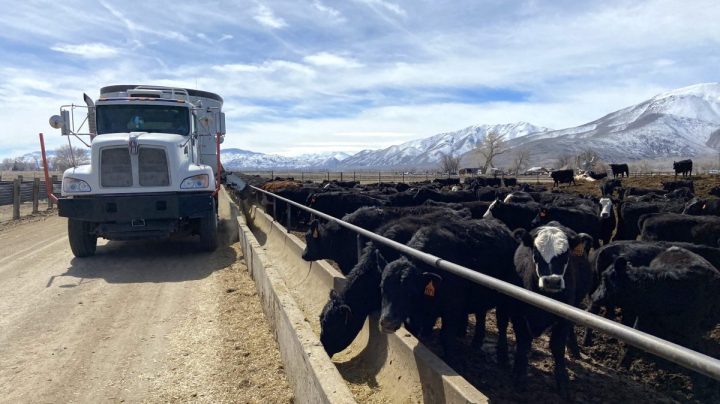
“It’s going to cost us a pile”: Livestock producers in West pinched by extreme winter weather
“It’s going to cost us a pile”: Livestock producers in West pinched by extreme winter weather

On a recent late morning at a snow-covered farm in Western Nevada, Lucy Rechel had a spring in her step.
Rechel, who manages the cattle operation at Snyder Livestock Company, said the cows were feeling good, too — because it was clear-skied and sunny.
“They’re enjoying it,” Rechel said. “They’re just like, ‘Ahhh, we’ll just stretch out and enjoy this.’ I mean, you can just see that they’re like, ‘Ahhh.’”
Sunny blue skies have been rare in Mason Valley this year. Many days have been filled with wind, rain or snowstorms.
“The ground very quickly turns to mud and we had more mud than I’ve ever seen,” Rechel said. “And it was very wet, sloppy, so the cattle were just standing in this soup. So, we had to take pretty significant action to get the cattle comfortable.”

Rechel said the company has spent $75,000 (and counting) to deal with mud, renting heavy mining equipment to haul out the mud and paying for the labor and fuel to run it. In a normal winter, she said they typically spend much less – roughly $10,000 – on mud removal.
Revenue is also a challenge because Rechel will have fewer cows this year. Local ranchers aren’t sending as many cattle as usual to her feedlot.
“Normally in January and February, we would have 5,500 (cattle) head here and we’re down to 4,000,” she said. “Income will be roughly two-thirds of what it is in a more average year.”
Livestock producers across the West are dealing with these same challenges. This year’s extreme cold snaps and heavy snowloads made life difficult for farmers and ranchers. That’s why, this winter, leaders in several Western states asked the U.S. Department of Agriculture for help.
In late March, the USDA designated some counties across Wyoming, Colorado, Montana and Utah as natural disaster areas due to extreme winter weather. That allows ranchers to apply for emergency loans.
But Nevada did not have any counties declared a natural disaster area due to winter storms. And J.J. Goicoechea, director of the Nevada Department of Agriculture, said ranchers in his state need help too.
“We’re just looking for some options for some producers if they do need some help,” he said.

One of those producers is Jon Griggs, who manages Maggie Creek Ranch in northeast Nevada. He said the harsh cold means cows need to eat more, and they have a hard time punching through the snow to graze.
“Cows’ nutritional requirements went through the roof because of that cold,” Griggs said. “And then with that snow cresting over, they can’t work their way through it anymore, and they lose condition and strength pretty quick.”
That means his cattle are surviving on hay. But the decades-long drought in the West has made hay expensive.
Two years ago, Nevada hay prices were $184 per ton. Ranchers are now paying nearly $300 per ton — if they can even find hay in their state.
“Some of these guys that I talked to have went into as far as central Idaho to try and get some hay trucked in,” Goicoechea said. “And so it really starts adding up.”
Back at the feedlot at Snyder Livestock Company, Lucy Rechel said she hopes livestock producers like her will get the emergency funding that they need.
“It’s going to cost us a pile to keep these cattle safe and comfortable, and then hopefully gaining weight,” Rechel said as a line of hungry cows were about to get fed at a trough.
Until then, Rechel’s hoping to have more days where these 4,000-some odd cows can stretch out under blue, sunny skies and not be stuck in mud.
There’s a lot happening in the world. Through it all, Marketplace is here for you.
You rely on Marketplace to break down the world’s events and tell you how it affects you in a fact-based, approachable way. We rely on your financial support to keep making that possible.
Your donation today powers the independent journalism that you rely on. For just $5/month, you can help sustain Marketplace so we can keep reporting on the things that matter to you.

















